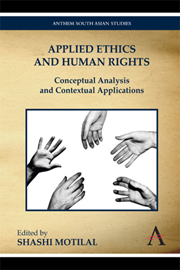Book contents
- Frontmatter
- Contents
- Preface
- Introduction
- Part One Rights, Obligations and Responsibilities
- 1 Applying Ethics: Modes, Motives and Levels of Commitment
- 2 Jurisprudence and the Individual: Bridging the General and the Particular
- 3 Why Moral Relativism Does Not Make Sense
- 4 Human Rights – A Theoretical Foray
- 5 Moral Relativism and Human Rights
- 6 Complicity and Responsibility
- 7 Dharma: The Overriding Principle of Indian Life and Thought
- 8 Moral Foundations of Social Order as Suggested in the Vaiśeṣikasūtras
- 9 Modern Western Conception of Justice as Equality before the Law and Dharmaśāstras
- Part Two Human Rights Issues
- Notes on Contributors
2 - Jurisprudence and the Individual: Bridging the General and the Particular
from Part One - Rights, Obligations and Responsibilities
Published online by Cambridge University Press: 05 March 2012
- Frontmatter
- Contents
- Preface
- Introduction
- Part One Rights, Obligations and Responsibilities
- 1 Applying Ethics: Modes, Motives and Levels of Commitment
- 2 Jurisprudence and the Individual: Bridging the General and the Particular
- 3 Why Moral Relativism Does Not Make Sense
- 4 Human Rights – A Theoretical Foray
- 5 Moral Relativism and Human Rights
- 6 Complicity and Responsibility
- 7 Dharma: The Overriding Principle of Indian Life and Thought
- 8 Moral Foundations of Social Order as Suggested in the Vaiśeṣikasūtras
- 9 Modern Western Conception of Justice as Equality before the Law and Dharmaśāstras
- Part Two Human Rights Issues
- Notes on Contributors
Summary
Positivism has often been compared to the revolution brought about in the natural sciences by Galileo, Newton, Dalton and their ilk. Before them, scientists confined their attention to the question ‘why’ – why, for example, did things fall down and not up, why did a moving body come to a stop, why did a stone fall faster than a feather, and so on. Philosophers like Aristotle sought to answer the questions by saying that it was the inherent nature of bodies to fall and stay at rest, and that heavier bodies tended to fall faster than lighter things.
Around the time of the Renaissance, however, thinkers realised that their insistence on the question ‘why’ was misplaced. They instead began to examine the question ‘how’ – as in how bodies fell, how moving bodies came to a standstill, and so on. Doing so, they came up with a set of rules explaining natural phenomenon that were both logically consistent and in agreement with observed facts.
Similarly, prior to the advent of positivism, legal thinkers tried to construe the law in terms of its purpose. They postulated that it was a means to give effect to divine will, justice, morality and so forth. Consequently, many held that laws that did not conform to these purposes were not laws at all, that is, they were devoid of legal sanction.
The positivists, on the other hand, realised that a law's objective has little bearing on its validity.
- Type
- Chapter
- Information
- Applied Ethics and Human RightsConceptual Analysis and Contextual Applications, pp. 33 - 50Publisher: Anthem PressPrint publication year: 2010

